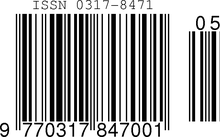Introduction to ISSN
– An ISSN is an eight-digit serial number used to identify a serial publication.
– It helps distinguish between serials with the same title.
– ISSNs are used in ordering, cataloging, and interlibrary loans.
– The ISSN system was first drafted as an ISO standard in 1971.
– ISO subcommittee TC 46/SC 9 is responsible for maintaining the standard.
Code Format and Assignment
– An ISSN is an eight-digit code divided by a hyphen into two four-digit numbers.
– The last digit is a check digit, uniquely representing the ISSN.
– The ISSN can be expressed as ‘NNNN-NNNC’ or using a regular expression.
– The check digit is calculated using a specific algorithm.
– The check digit can be a digit from 0 to 9 or an uppercase X.
– ISSN codes are assigned by ISSN National Centres.
– The ISSN International Centre in Paris coordinates the network of National Centres.
– The International Centre is an intergovernmental organization.
Linking ISSN
– ISSN-L is a unique identifier for different media versions of the same serial.
– It facilitates collocation and linking among various media versions.
– ISSN-L is based on the ISSN of the first published medium version.
– It does not change the use or assignment of ordinary ISSNs.
– ISSN-L is useful for search, retrieval, and delivery across all media versions.
Comparison with Other Identifiers
– ISSN and ISBN codes serve similar purposes.
– ISBNs are assigned to individual books, while ISSN is for serials.
– An ISSN is anonymous and does not provide publisher or location information.
– ISSN is assigned each time a serial undergoes a major title change.
– Extensions like PII and SICI allow references to specific components of a serial.
Problems and Additional Resources
– ISSN is not unique when the concept is a journal with multiple contents and copyrights.
– The U.S. National Library of Medicine created the NLM Unique ID (JID) to address this issue.
– ISSN does not offer resolution mechanisms like DOI or URN.
– DOI is often used as a URN for articles.
– There is no ISSN online service to resolve the ISSN of a journal.
– CODEN is another identification system used for scientific and technical publications.
– WorldCat is an ISSN-resolve service that helps in locating publications.
– There are various references and resources available for further information on ISSN.
– These resources provide guidance on using ISSN as URN and metadata standards.
– The ISSN International Centre and Library of Congress provide information on obtaining ISSN.
Note: The content about URNs, media category labels, and ROAD could not be included in the groups as they do not have identical concepts with other parts of the content.
An International Standard Serial Number (ISSN) is an eight-digit serial number used to uniquely identify a serial publication, such as a magazine. The ISSN is especially helpful in distinguishing between serials with the same title. ISSNs are used in ordering, cataloging, interlibrary loans, and other practices in connection with serial literature.
 | |
| Acronym | ISSN |
|---|---|
| Organisation | ISSN International Centre |
| Introduced | 1976 |
| No. issued | > 2,500,000 |
| No. of digits | 8 |
| Check digit | Weighted sum |
| Example | 2049-3630 |
| Website | www |



The ISSN system was first drafted as an International Organization for Standardization (ISO) international standard in 1971 and published as ISO 3297 in 1975. ISO subcommittee TC 46/SC 9 is responsible for maintaining the standard.
When a serial with the same content is published in more than one media type, a different ISSN is assigned to each media type. For example, many serials are published both in print and electronic media. The ISSN system refers to these types as print ISSN (p-ISSN) and electronic ISSN (e-ISSN). Consequently, as defined in ISO 3297:2007, every serial in the ISSN system is also assigned a linking ISSN (ISSN-L), typically the same as the ISSN assigned to the serial in its first published medium, which links together all ISSNs assigned to the serial in every medium.
1912 NW 143rd Ave #24,
Portland, OR 97229, USA